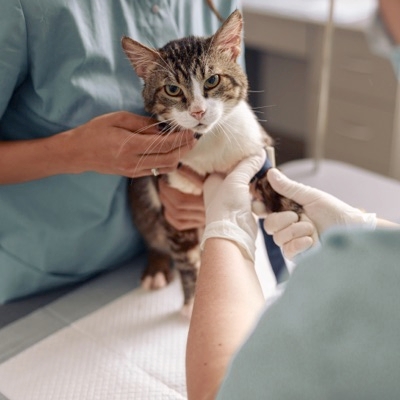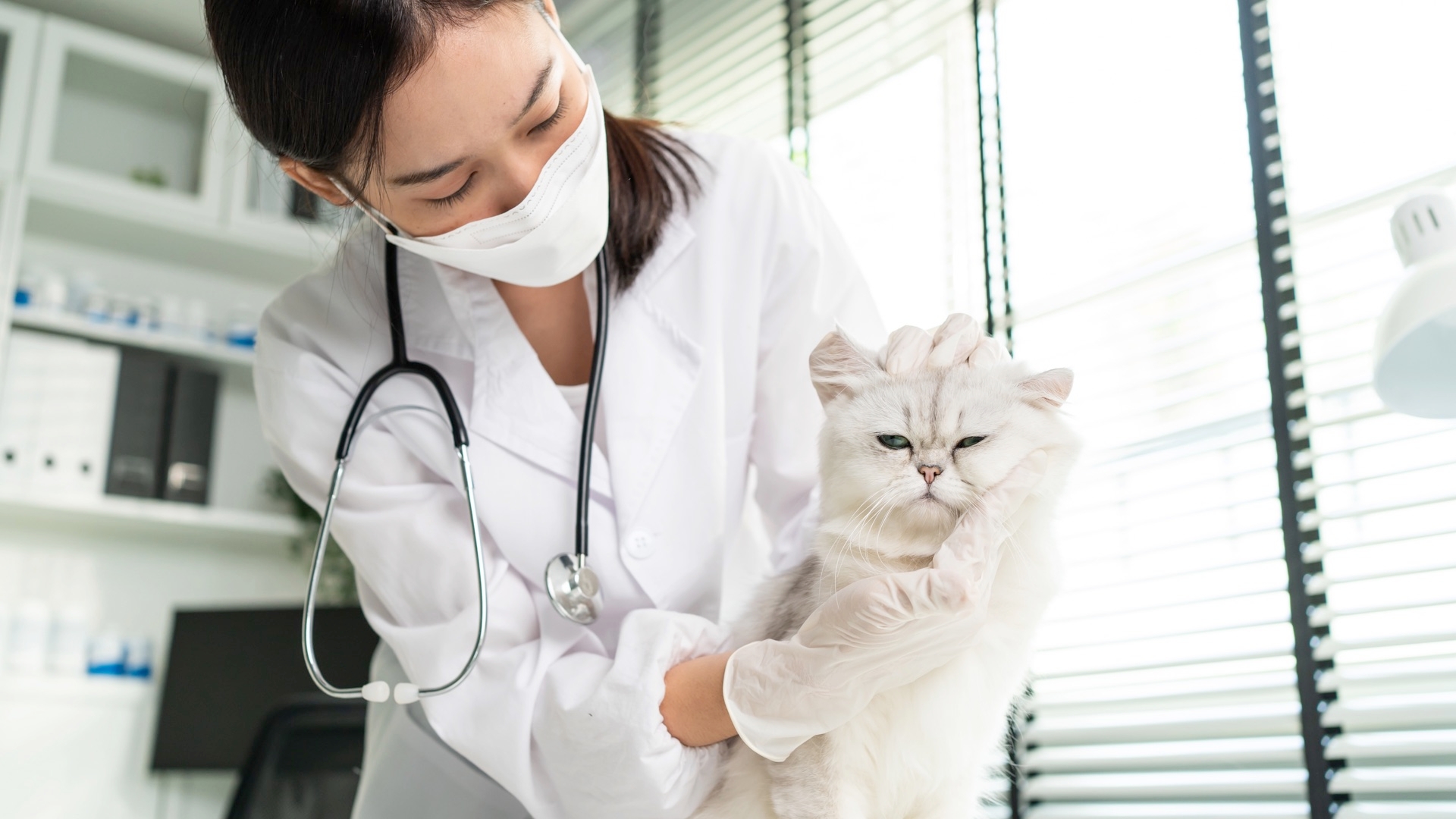Top Ten (10) Reasons To Take Your Cat To The Vet:
Summary:
There is a common misconception that cats can "take care of themselves." Consequently, they are taken to the veterinarian far less frequently than dogs, statistically about half as often. Like all companion animals, though, cats require ongoing veterinary care to live happy, healthy lives.


There is a common misconception that cats can "take care of themselves." Consequently, they are taken to the veterinarian far less frequently than dogs, statistically about half as often. Like all companion animals, though, cats require ongoing veterinary care to live happy, healthy lives. Regular checkups are even more critical for cats because they instinctively hide signs of illness. This behavior, developed in the wild to disguise cats' weaknesses from predators, serves little purpose for domesticated cats. In fact, subtle signs of illness in cats often are overlooked or mistaken for behavior problems, which is why it is extremely important to bring your cat to the veterinarian for regular checkups and when you notice even slight changes in behavior.
If you do not already have a veterinarian, talk to friends and relatives, or contact your local humane society for a referral. In some cases, it may be advantageous to see a veterinarian at a feline-only hospital or a veterinarian at a mixed (dog/cat) practice who has a special interest in feline medicine. Members of the American Association of Feline Practitioners (AAFP) can be found at catvets.com. Also, just as there are board certified specialists in veterinary cardiology and oncology, there are specialists in feline medicine who are certified by the American Board of Veterinary Practitioners (ABVP). Names of veterinarians boarded in feline medicine can be found at abvp.com or catvets.com.
Visit the clinic or hospital you are considering and ask questions about the facility, including available services, hours, etc. Make sure you're comfortable with the environment, as well as the professionalism and friendliness of the doctors and staff.
Schedule an appointment for a checkup. Make sure you like the way the veterinarian communicates with you and handles your cat. If you don't, then continue trying new veterinarians or clinics until you find a place you like. It's best to establish a good relationship with a veterinarian before an emergency arises. If the clinic you choose doesn't have emergency services, find out where the nearest emergency veterinary clinic is located or where your veterinary hospital refers patients after hours.
Below is a list of changes that may signal that your cat is not feeling well. These are only guidelines and are not by themselves definitively diagnostic for a specific condition. Rather, they indicate that a veterinary visit may be needed. You know your cat's habits and behavior better than anyone. Do not ignore changes that may indicate a developing health issue. If there is a sudden change in behavior, see your veterinarian as soon as possible.
Even if your cat shows none of these signs, consider scheduling wellness examinations every six months. Diagnosing disease early can be the key to successful treatment and may be less costly in the long run. Often, by the time cats display an illness, the disease has progressed significantly, necessitating more extensive and costly treatment.
The "Subtle Signs of Sickness," written by Fort Dodge Animal Health and the AAFP and adapted by Tree House, include:
Inappropriate elimination
This is one of the most common reasons given for relinquishing cats to shelters. Guardians often assume that the problem is behavioral, so they don't seek medical help. When a cat begins to urinate or defecate outside the litter box, medical conditions must be ruled out before behavioral intervention is attempted. Any cat that does not feel well for any reason may behave differently, and in cats, that behavior may include eliminating outside the litter box. Defecation outside the box can be a sign of inflammatory bowel disease, constipation, arthritis, or other medical conditions. Cats may urinate outside the box because of Feline Lower Urinary Tract Disease (FLUTD), kidney disease, Cognitive Dysfunction Syndrome (kitty Alzheimer's), hyperthyroidism, diabetes, etc. The urinary tract also can become blocked by crystals, stones, or mucous plugs. This is a medical emergency, especially in male cats, who are more prone to urinary tract blockages because of the anatomy of their urinary tracts. These cats can quickly become sick and die as toxins that normally are eliminated via the urinary tract instead build up in their bloodstream. Signs of blockage include straining in or out of the box but only producing a small amount of urine or none at all, frequent trips to the box, and/or vocalizing while attempting to urinate.
Once medical problems have effectively been eliminated, or while they are being resolved, you can address litter box problems associated with behavior. For more information on litter box problems, see Litter Box 101.
Changes in interaction
A cat who suddenly has little desire for attention from his human family may not be feeling well. For a normally docile cat, general irritability or aggression towards people or other animals can be a sign of pain. Having regular playtime and routines for interacting with your cat will help you notice sudden behavioral changes.
Changes in activity
Decreased physical activity can be caused by medical conditions that result in pain, discomfort, or lack of energy. As cats age, they can develop arthritis and other illnesses that may cause them to be less active or playful. However, not all cats slow down in old age. Some older cats can experience increased physical activity, which can be a sign of hyperthyroidism.
Changes in sleeping habits
Knowing your cat's daily habits will help you determine if there is a significant change in his normal sleep pattern. On average, cats can spend 16 to 18 hours daily sleeping. Daytime rest generally consists of several catnaps. These naps aren't typically deep sleeps, so cats usually can be roused by normal household sounds and other stimuli, such as light petting or food. If a cat is sleeping more often and/or more deeply than usual or has difficulty lying down and getting up, it could signal an underlying problem.
Changes in food/water consumption
Most cats eat well and regularly, provided they are offered food they enjoy. Get to know your cat's eating and drinking habits; they are valuable indicators of the cat's overall health. Increased food consumption can point to problems such as diabetes or hyperthyroidism. Increased water consumption can indicate kidney disease, diabetes, hyperthyroidism, or other conditions. Many diseases can cause cats to decrease their food intake or stop eating altogether, which can lead to rapid, even dangerous, weight loss. A cat who has not eaten at all for more than a day is at potential risk of developing serious liver problems. Meal feeding your cat is preferable to free feeding, in part because if your cat's eating patterns change you will notice it right away.
Unexplained weight loss or gain
Cats can gain or lose weight even when they continue to eat normally, and such instances point toward one or more underlying health problems, such as hyperthyroidism. Obesity is a significant health issue. Studies indicate that 50 percent or more of indoor cats are overweight, which can lead to or be a complicating factor in a long list of medical and behavior problems, including diabetes, heart disease, and joint problems, as well as an overall reduced quality of life. Cats should be weighed regularly to determine if they are maintaining their ideal weight. This can be done at home with a scale designed for weighing cats (pediatric human scales or any scale that weighs to the ounce will work well) or at regular veterinary visits. Weight checks are another good reason for semiannual exams. It may not be apparent that your cat has lost weight, but even the slightest weight loss can be cause for concern. For example, a 12-pound cat losing 3 pounds may not seem significant, but this is akin to a 160-pound person shedding 40 pounds. If such weight loss was not planned and/or happened too quickly, it could indicate an underlying medical cause.
Changes in grooming
Cats are generally meticulous groomers and maintain their coats in a healthy and lustrous condition, free of mats. Areas of fur loss or an unkempt appearance can be signs of disease. Overweight and/or arthritic cats may have trouble grooming their hindquarters and may need help keeping those areas clean. Anxiety and depression can cause cats to groom improperly as well, but as always, it is best to rule out physical causes first. Excessive grooming might indicate allergies or skin irritation. If your cat is over-grooming certain areas, look at the skin in those areas to see if there are any abnormalities. Also, keep in mind that even indoor cats can become infested with fleas, and flea allergies can cause over-grooming.
Signs of stress
Stress (as experienced by the cat) can result from good or bad events. A situation that a cat perceives as stressful may or may not be seen the same way by his human family. Any change within a household can potentially be a source of stress to the family cat, so changes should be made slowly and carefully. At times of stress, cats may hide, become depressed, and eat more or less than usual. Because these same signs can be indicators of medical problems, and because stress can also prompt the onset of disease, cats should visit the veterinarian when they show these signs. It is also important to recognize that chronic or long-term boredom can be a stressful situation for cats, just as in people. As discussed above, stress can lead to depression along with a host of other health and quality-of-life issues. Cats like to play and be mentally challenged just as we do. Your cat will benefit from daily interactive play to keep him active and stimulated.
Changes in vocalization
Increased vocalization or howling tends to be more common in older cats, and it can signal an underlying medical condition such as hyperthyroidism. Pain also can cause cats to be more vocal, so schedule a veterinary visit if your quiet cat suddenly develops inexplicable howling behavior. In elderly cats, howling may be a sign of hearing loss or feline cognitive syndrome, the latter of which may be helped by medication.
Bad breath
Bad breath can be caused by conditions such as kidney failure or diabetes, but it is most often an indicator of poor dental health. Dental disease is common in cats; some sources suggest that 70 percent have gum disease as early as age three. You may be able to see tartar on your cat's teeth, but the majority of dental problems in cats involve pathology that is below the gum line. Cats should have their teeth examined at least annually. Home tooth brushing in conjunction with regular veterinary dental care can prevent bad breath, painful teeth and gums, tooth loss, and spread of infection to other organs.


